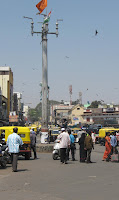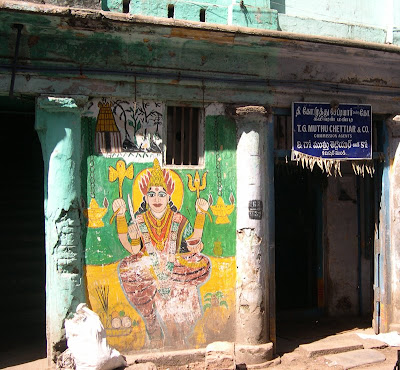 To begin a thought process on the regeneration of the Russell Market heritage precinct, i look at the history of the market and the history of its neighbourhood. Today, it is also possible for us to easily access a map of the area using Google Earth. One notices in the image included below that the red spot, which represents Russell market is at the centre of a dense urban fabric of old bangalore. There are several main roads that radially converge to the Market Square. This so emphatically confirms the importance of this area in the way the city grew.
To begin a thought process on the regeneration of the Russell Market heritage precinct, i look at the history of the market and the history of its neighbourhood. Today, it is also possible for us to easily access a map of the area using Google Earth. One notices in the image included below that the red spot, which represents Russell market is at the centre of a dense urban fabric of old bangalore. There are several main roads that radially converge to the Market Square. This so emphatically confirms the importance of this area in the way the city grew.The picture shown above is of the Russell Market Square in ShivajiNagar, Bangalore. The photograph was taken in February 2009

V.L.S.Prakasa Rao & Vinod K.Tewari describe the development of the City Market and the Russell Market in ‘The Ecological Structure of Bangalore City’*
"The Fort near the City Market on the west, and the Barracks near the Ulsoor Tank on the east, were the two foundations of Bangalore City. The two kernels of the city, situated only 4 miles apart, were founded with a time-lag of more than two and a half centuries-the Fort built in 1537 and the British Garrison and Barracks established in 1809. The neighbourhood of the Fort and the neighbourhood of the Ulsoor Tank developed under two different raisons d’etre. The defensive strong point apart, the Fort city was oriented to the philosophy of a city and temple builder, an agriculturist turned warrior, under whose patronage developed a township of wholesale and retail traders, and of highly skilled artisans particularly families of cotton weavers (Hasan 1970, Rao 1930)
In contrast to this, the neighbourhood of the Ulsoor Tank was developed to cater to the requirements of the British troops and British officers who were pulled out of Srirangapatnam and settled near the tank. Thus, a military cantonment developed along with a civilian settlement of mainly retail traders and service classes adjoining the Ulsoor village. While the Fort neighbourhood developed as a typical native town with its bazaar, traders and artisans, the Ulsoor neighbourhood developed as a cantonment with its artillery and cavalry barracks, parade ground, infantry road, the Mall, fine and spacious bungalows, bars and night clubs.
Both the nuclei expanded; the Fort neighbourhood expanded east, north and south, and the Ulsoor neighbourhood expanded west, north and south, invading the open spaces and fertile agricultural lands. With the development of the Russell market and westward expansion of the cantonment, the nucleus of the west shifted to Russell market locality, while the development of the City market near the Fort contributed to further intensification of the growing nucleus of the west. The east-west zonation certainly had its intermixing and integrating social-cultural elements in the two nuclei : temples, churches and mosques near both the City market and the Russell Market. Even the street names such as Dharmaraya Koil Street and Meenakshi Koil Street in the predominantly Muslim and Christian areas near the Russell Market, and Sultanpet near the City Market, a predominantly Hindu area, only echo the co-existence of the different religious communities."
 One finds a similar pattern of urban development in Georgetown, an old historic settlement in Madras, now Chennai. There is the Fort St.George nearby whose establishment soon generated a neighbourhood of retail traders and also artisans who initially came to Madras on short visits and later settled here to support the growing town. The history of Indian city centers seems to reflect a marked connection between artisan settlements, a central market and a religious establishment, and going back a little further, a connection perhaps to a nearby fortified British settlement or Fort, that the artisans, the local traders and the priest community initially served.
One finds a similar pattern of urban development in Georgetown, an old historic settlement in Madras, now Chennai. There is the Fort St.George nearby whose establishment soon generated a neighbourhood of retail traders and also artisans who initially came to Madras on short visits and later settled here to support the growing town. The history of Indian city centers seems to reflect a marked connection between artisan settlements, a central market and a religious establishment, and going back a little further, a connection perhaps to a nearby fortified British settlement or Fort, that the artisans, the local traders and the priest community initially served.The above picture shows a typical street in Georgetown, the photograph was taken in January 2008
*Tewari, Vinod K., Indian Cities-Ecological Perspectives, Concept Publishing Company, New Delhi, 1986
Related Posts :
What is Russell Market
How Green is my Bazaar
Marketplaces and Tourism
The Informal Economy and Urban space




